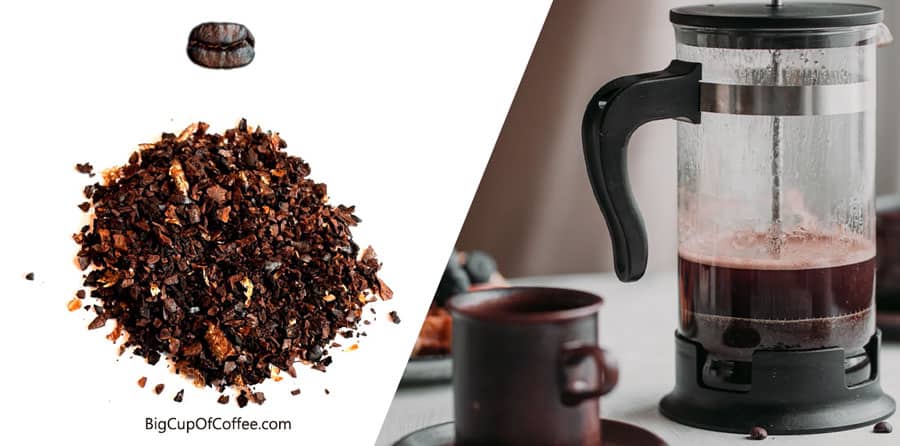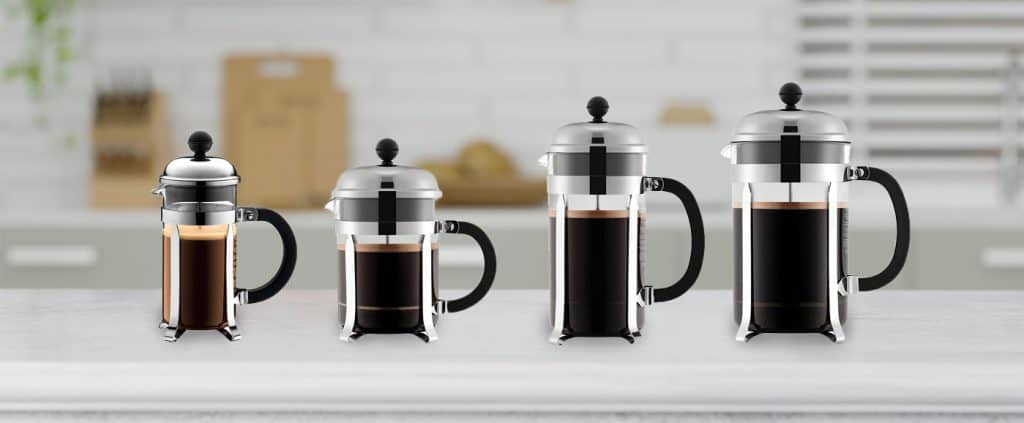French Press vs Espresso: What’s Special in Each (A Barista’s Review)
I’ve tried countless brewing methods to satisfy my caffeine cravings. So every time I come across someone who swears by either French Press or espresso, it leaves me wondering, which one is truly the superior choice?
With both methods gaining immense popularity in recent years, it’s really hard to pick a clear winner. That’s why in this article, I’ll take an in-depth look at the factors that coffee lovers would want to consider when picking a brewer.
After reading this through, you’ll be able to make an informed decision on which method suits your taste and lifestyle.
Let’s get into it.
Comparing French Press & Espresso – Which Method is Better?
So, which is better, the French Press or espresso? It depends on what you’re looking for in your coffee, as they are totally different.


The French Press is an immersion brewing method using a cylindrical glass or stainless steel container. You start by pouring hot water at 195°F to 205°F over medium-coarse to coarse ground coffee- allowing them to steep for several minutes. During this immersion, the water soaks up all of the flavors and oils from the beans. A metal mesh screen attached to the plunger then filters out those grounds as you press it downwards.
On the other hand, espresso is brewed fast and furiously. Finely ground coffee beans are packed tightly into a portafilter, which is locked in place inside an espresso machine. Hot water is forced through these compressed grounds at high pressure (9 bars) and in just 25 to 30 seconds, produces an intense shot of concentrated coffee loaded with flavor, coffee oils, and a beautiful crema.
Here are the factors to consider when picking between the two brewing methods, followed by a detailed comparison of each feature.
| Features | French Press | Espresso |
|---|---|---|
| Taste & Flavor | Full-bodied, robust flavors, more oils and sediments | Strong, concentrated, bold flavor, beautiful crema |
| Strength | Moderate | High |
| Ease of Use | Relatively straightforward and simple | Requires practice and skill |
| Brewing Speed | 6-7 minutes | 2 minutes |
| Versatility | Limited to hot coffee, except for cold brew | Offers control over various elements for customized shots |
| Durability & Portability | Borosilicate glass or stainless steel, portable | Larger size, not designed for portability |
| Sustainability | Sustainable, no electricity required, recyclable materials | Consumes energy during production, plastic components |
| Cost | Affordable, ranging from $20 to over $100 | Expensive, ranging from $100 to several thousand dollars |
Taste, Flavor, & Strength
The French Press and espresso offer very different experiences when it comes to taste. A cup of French Press coffee is full-bodied with robust flavors that vary depending on the type of beans used, with a metal mesh filter that allows for more oils and sediments to end up in your cup.
On the other hand, espresso is known for being a strong and concentrated coffee that packs a punch. With its potent flavor and beautiful crema on top, no other brewing method can replicate what an espresso shot offers. As a result of using high pressure, espresso tends to be bolder than regular coffee both in terms of caffeine concentration and taste.
This is also why espresso is often served with sparkling water, so you can cleanse your palate before appreciating its flavors.
If you ask me which brewing method is better in terms of flavor, I’d say the espresso is a lot better than the French press. It has an unparalleled flavor that gets even better when you introduce other ingredients to it such as milk and sweeteners (here are some espresso + milk drink recipes).
With that said, both drinks have their own charm so it’s worth trying out both options to see which one suits your taste buds the best.
Ease of Use
Weighing how easy making coffee is with each method, the French press takes the win over espresso. Brewing with a French press is relatively straightforward and simple. You start by heating water to the desired temperature (195°F – 205°F) and grinding your coffee beans to a medium-coarse or coarse grind size. Combine the two and let them steep in the pot before pressing down on the plunger to get the final drink.

On the other hand, making an espresso requires significant practice and skill to master due to its complex nature. It isn’t just about choosing quality beans; one has to pay attention to several factors such as roast level, temperature, fine grind size, tamping pressure, and more just for a perfect shot.

So if you’re trying to get a great cup of coffee with little to no learning curve, the French press is for you. However, if you don’t mind taking the time to master using the espresso machine, pulling consistent shots can soon be second nature to you which is also far more rewarding.
Brewing Speed
In terms of how fast you can fix a cup of coffee, espresso is way quicker to make compared to the French press. Pulling a shot of espresso only takes 25 to 30 seconds. This, combined with preparing your coffee grounds and cleaning up after, takes approximately two minutes in total.
As for the French press, it takes 6 to 7 minutes from preparing your ground coffee to brewing and cleaning up. This brewer takes some effort to clean as you have to disassemble it and scrub out the grounds, but it’s not too difficult overall.
When cleaning a home espresso machine, you have to rinse out the portafilter and basket that held the ground coffee, and if applicable, wipe and purge the steam wand. Remember that espresso machines also need deeper cleanings such as descaling or backflushing, which aren’t as frequent but can take more time to do.
So if you’re always rushing to get that caffeine kick, then the espresso machine is your best pick. But if you want to brew coffee even if you’re on the go, then the French press might be worth considering.
Versatility
The versatility of the brewing method is an essential aspect because it allows you to achieve different flavor profiles. In this regard, the espresso takes the lead.
Being a precise and elaborate method, espresso requires expertise in controlling grind size, dosage, distribution, tamping pressure, water temperature, and extraction time. You can control each of these elements to create your perfect shot of espresso that’s rich in aroma and flavor.
On the other hand, French Press doesn’t offer much flexibility as it only produces a single type of hot coffee beverage, except if you use it to make a cold brew.
As for the flexibility in capacity, the espresso produces a shot or two each pull, at one ounce per shot.
As for the French press, it has varying capacities to cater to different coffee needs in terms of servings:
- 3-cup (0.35 L)
- 4-cup (0.5 L)
- 8-cup (1 L)
- 12-cup (1.5 L)

To summarize, espresso is right for you if you want more control over the coffee-making process, but if you prefer a simple yet effective brewing method that has a wider range of capacities, then French press is a worthy option.
Durability and Portability
Regarding durability, the classic French press commonly has a borosilicate glass body, which handles heat and thermal shocks pretty well. If you don’t want to worry about potential breakage though, there are stainless steel variants as highly durable alternatives. Because of its compact and manual nature of brewing, the metal French press is also great on the go and outdoors.
On the other hand, espresso machines tend to be larger than French presses. Commercial-grade models often use heavy-duty materials and take up a considerable amount of space. Home models range from small appliances to larger pieces of equipment, with varying levels of durability based on their size and materials. However, espresso machines aren’t built for travel and are designed to stay on your kitchen counter.
Espresso machines aren’t portable and are more prone to breaking down, so I’ll have to give this category to the French press.
Sustainability
Sustainability is an important factor to consider when it comes to coffee. Not only does it impact the environment, but it also affects the long-term viability of our favorite beverage.
While commercial-grade espresso machines consume significant amounts of energy during their production process – making them particularly unsustainable – home versions require less electricity consumption for brewing. On the other hand, the French Press requires no electricity at all.
With no disposable components like paper or plastic filters and fewer parts than many other methods, the French Press is generally considered a sustainable coffee brewing option as there’s very little waste produced. In contrast, espresso machines consume a considerable amount of resources.
As for the materials used, the glass or stainless steel French presses are very recyclable, while espresso machines contain numerous components leading to excess environmental harm.
All things considered, the French press is really the better option when it comes to making coffee while staying eco-friendly. To further make each cup sustainable, you can also opt for environmentally-friendly coffee, and recycling waste such as used coffee grounds.
Cost
When it comes to cost, there is a stark contrast between French Press and espresso. If you’re looking for an affordable option, then the French Press may be your go-to choice. Prices range from around $20 to upwards of a hundred dollars depending on size and material.
Compared to home espresso machines, this seems like pocket change. Espresso machines are often expensive with prices varying widely based on quality and features and can range from around $100 to several thousand dollars.
While the initial expense of purchasing an espresso machine may seem daunting at first glance – especially when compared with French Press -the long-term value it provides could really be worth it. However, if affordability is your top priority without compromising taste and convenience, I recommend going for a high-quality French press instead.
French Press and Espresso – Weighing the Pros & Cons
Now that we’ve gotten a closer look at the features of each brewing method, here’s a quick overview of the pros and cons of French Press and Espresso so you can finally decide which one is for you:
| Brewing Method | Pros | Cons |
|---|---|---|
| French Press | – Easy to use – The glass material offers decent heat retention – Stainless steel models offer durability | – Some sediments may get into your drink – Common glass build is prone to breakage |
| Espresso | – Produces highly-concentrated coffee with crema on top – Very fast to produce – Can be used for numerous recipes | – The espresso machine is not portable – Generally expensive – Requires finely ground coffee beans – Dialing in the espresso requires expertise |
Is French press one of your favorite brewers? Here are my other comparisons between this coffee maker and other brewing methods:
You can also check out how espresso compares to other brewers:
Conclusion
To summarize, if you’re looking for an easy-to-use, versatile, and portable brewing option, then a French Press might be your best bet. But if you want highly-concentrated coffee with crema on top that can be used for numerous recipes, then espresso might be right up your alley.
Personally, I prefer the espresso machine because I can replicate my favorite drinks from the café: I can make a latte, cappuccino, and so much more, plus it even saves me money.
How about you, which brewing method do you like better? Let me know in the comments.








